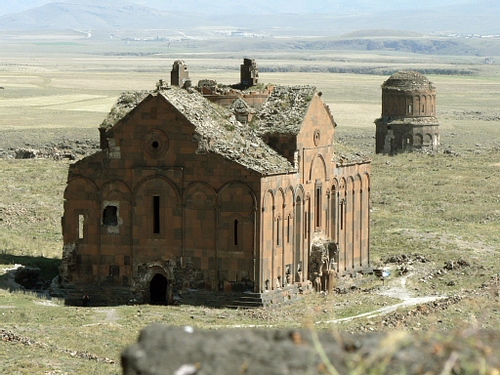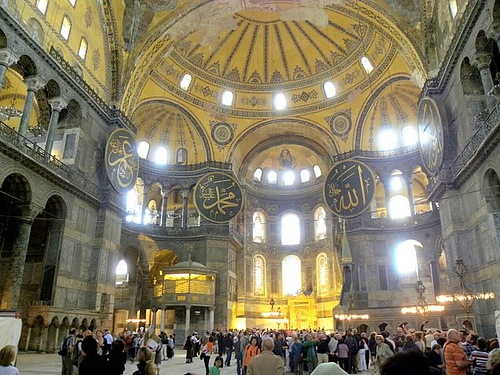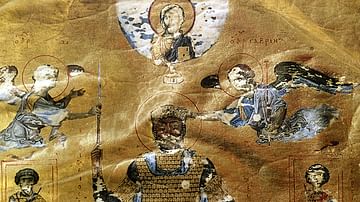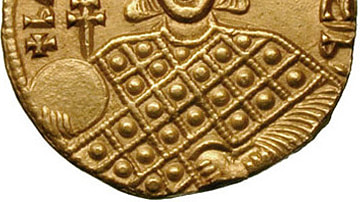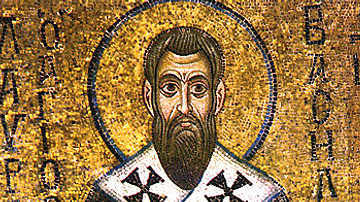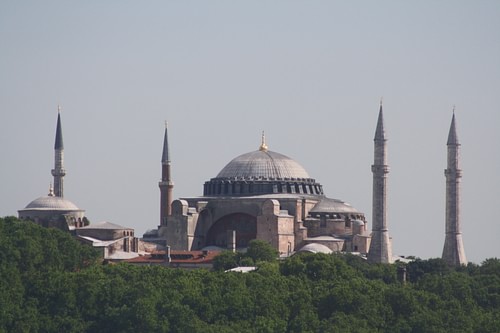
“Trdat the Architect” or Tiridates (c. 940s-c. 1020s?) was a Armenian architect who is noted for his role in the reconstruction of the Hagia Sophia's dome in Constantinople following an earthquake in the 10th century CE, as well as the Cathedral of Ani and the Church of Gagik in what is now present-day Turkey. Along with Momik (c.1270-1333 CE), Trdat is the most famous Armenian architect of the Middle Ages.
Very little if anything concrete is known about Trdat's earliest years aside from that he was Armenian with extensive talents in mathematics and architectural design. Trdat's life coincided with the medieval Armenian golden era as well as the so-called “Macedonian Renaissance” of the Byzantine Empire (867-1056 CE). After centuries of intermittent warfare and constant invasions, Armenians and Byzantines halted the tide of the Arab onslaught, stabilizing their borders and safeguarding their population centers. This was a time of political and economic stability in addition to cultural effervescence in both Armenia and Byzantium. Historians and archaeologists can trace Trdat's movements based on his construction and reconstruction projects around historical Armenia as well as the Byzantine Empire. Trdat lived and worked primarily in Shirak province, which in the 10th and 11th century CE included the city of Ani, the capital of Bagratid Armenia (885-1045 CE).
Work in Ani & Shirak
Trdat is sometimes credited as the architect responsible for the construction of several churches at the Sanahin Monastery, the Haghpat Monastery, and the Marmashen Monastery, which are all located in present-day Armenia. According to the Universal History, written by the Armenian historian Stepanos Asoghik in the 11th century CE, Trdat is mentioned by name as responsible for the construction of the Argina Cathedral, which had become the seat of the Armenian Catholicos in the late 9th century CE. Located just to the north of Ani and in a current state of partial collapse, Argina Cathedral was once an aisleless structure characterized by a dome on pendentives. This cathedral's linearity and longitudinal space divided by piers foreshadowed Trdat's subsequent work on Ani Cathedral.
Historians are able to trace Trdat's life primarily through his work in and around Ani, although it should be noted that Trdat was active in Armenia prior to and after his repair of the Hagia Sophia. Ani was a new, but grand city that stood at the crossroads of trade between the Byzantine Empire, the Abbasid Caliphate, the Kievan Rus, and the Persianate states of Central Asia. Founded in 961 CE, Ani grew quickly and at its height, it contained a population of perhaps 100,000 people. Because of the city's rapid growth, King Ashot III of Armenia (r. 953-977 CE) and his sons, King Smbat II (r. 977-989 CE) and King Gagik I (r. 989-1020 CE), ordered the construction of new walls, public spaces, caravanserai (roadside inns), and churches. Ani soon became known throughout the Near East and Mediterranean as the “city of a thousand and one churches."
In 989, Smbat II commanded Trdat to build a new cathedral in Ani and construction of this building ended around 1001-1006 CE under the supervision of Queen Katramide (c. 970-1010 CE), the wife of Gagik I and sister of King Bagrat III of Georgia (r. 1008–1014 CE). Historians contend that Trdat then worked on the Church of Gagik (occasionally referred to as Gagkasen). This church, dedicated to St. Gregory of Armenia, was built in imitation of Zvartnots Cathedral, having "brilliant splendor, lofty vaults, and a sanctuary surmounted by a heaven-like dome” ( Evans et al, 352). However, despite their similarities, Trdat elongates the church's arches and supports, and profiles large interior spaces at the Church of Gagik. Trdat here was perhaps influenced by the linear aesthetics of the Hagia Sophia and other Byzantine churches.
Work in Constantinople
It is not known how Trdat first came to Constantinople and was ultimately entrusted with the reconstruction of the Hagia Sophia, following an earthquake in 988 CE. It is entirely possible that Trdat was already in Constantinople while work halted on Ani Cathedral after the death of Smbat II in 989 CE. Armenians frequently rose to positions of great prominence as scholars, generals, and rulers under the Byzantine emperors of the Macedonian dynasty (867-1056 CE). Many of the Byzantine emperors of this dynasty were also either Armenian or partially Armenian by ancestry. Emperor Basil II (r 976-1025 CE.), ever concerned with the boundaries of his eastern frontier with the Georgians, Armenians, and Arabs, might have heard of Trdat and his work from those he encountered while campaigning in the Caucasus. According to the Chronicle of the Armenian historian Matthew of Edessa (d. 1144 CE), Basil II conversed with Armenian scholars during his frequent travels throughout the Caucasus.
Byzantine churches were quite different from the imposing and austere, geometric stone structures the Armenians employed to support their faceted-domed churches. The Byzantines favored bricks and mortar in their churches, avoiding too the conical domes favored by Armenians. Nonetheless, Trdat was charged by Basil II to repair the Hagia Sophia's western dome arch. This was no simple task as the Hagia Sophia employs four triangular pendentives to transpose the weight of its circular dome to a quadrilateral supporting superstructure without the use of columns or pillars in interior spaces. Trdat rebuilt and strengthened the destroyed dome arch with fifteen dome ribs. Repair and reconstruction took six years, and the Hagia Sophia reopened in 994 CE. The fact that the Hagia Sophia has not suffered severe damage in the same area for over 1,000 years serves as a testimony to Trdat's brilliance and acumen as an architect.
Legacy
Trdat stands out amongst medieval Armenian architects as he undertook large-scale projects in both Armenia and Byzantium. The scholastic debate as to the amount of cross-cultural exchange in architecture facilitated by Trdat continues, but it is difficult to deny that Trdat's enduring legacy lies in his ability to have refined and expanded the architectural models and traditions of his Armenian and Byzantine patrons.
This article was made possible with generous support from the National Association for Armenian Studies and Research and the Knights of Vartan Fund for Armenian Studies.

